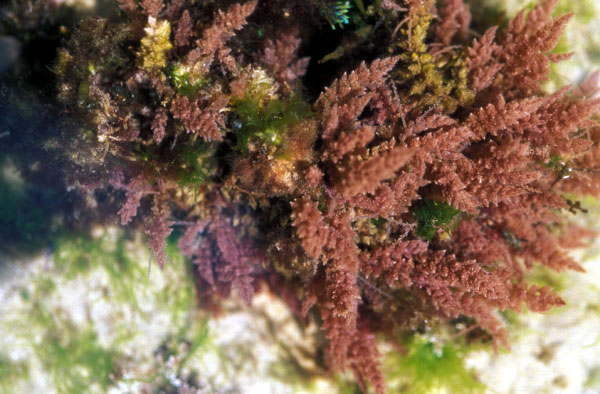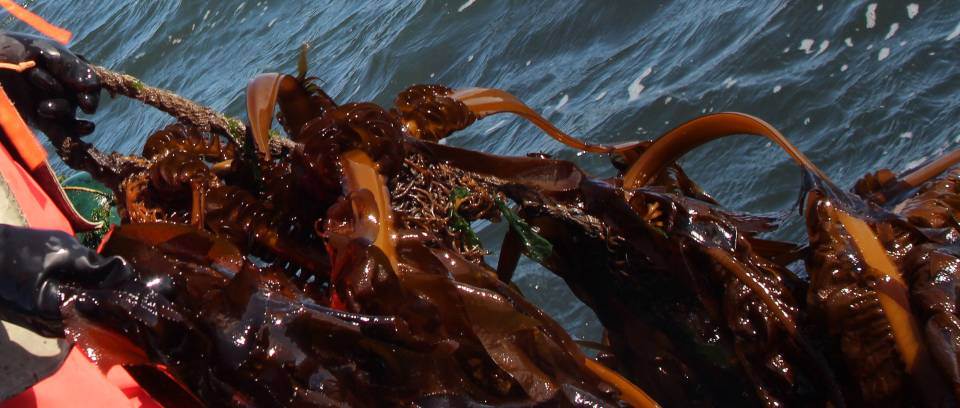The present study was to determine the effects of salinity on the growth and nutrient bioextraction abilities of Gracilaria and Ulva species, and to determine if these seaweeds can be used for nutrient bioextraction under hypo- and / or hyperosmotic conditions. Two Gracilaria species, G. chorda and G. vermiculophylla, and two Ulva species, U. prolifera and U. compressa, were cultured at various salinity conditions (5, 10, 15, 20, 30, 40, and 50 psu) for 3 weeks. Results showed that the growth rates, nutrient uptake, tissue nutrient contents and nutrient removal were significantly affected by salinity and species. All four species were euryhaline with the highest growth rates at 20 psu. Among the four species, U. prolifera, U. compressa, and G. vermiculophylla showed potential to be used for nutrient bioextraction in estuaries and / or land-based fish farms due to their rapid growth, high nutrient uptake, high tissue carbon and nitrogen accumulation and removal capacities.
Digital library
-
-
Marine biorefineries, based on macroalgal (seaweed) feedstocks, could provide sustainable alternative sources of food, energy, and materials. Green macroalgae, with their unique chemical composition, can contribute to marine biorefinery systems associated with a wide range of potential products. This review discusses the challenge of developing industrially relevant and environmentally-friendly green seaweed biorefineries. First, we review potential products from green seaweeds and their co-production, the key element in an integrated biorefinery. Second, we discuss large-scale cultivation, hydrothermal treatments, fermentation, anaerobic digestion, and emerging green solvents, pulsed electric field, microwave, and ultrasound processing technologies. Finally, we analyse the main polysaccharides in green seaweeds: sulfated polysaccharides, starch, and cellulose, as products of a cascading biorefinery, with emphasis on applications and technological challenges. We provide a comprehensive state-of-the-art review of green seaweed as feedstock for the biorefinery, analysing opportunities and challenges in the field.
-
The seaweeds are a diverse group of large marine macroalgae that are as important to the marine world as land plants are to our terrestrial world. Seaweeds were the precursors to land plants, and like land plants, they are critical primary producers, forming living links between the inorganic and the organic world, using photosynthesis to convert CO2 and nutrients into living biomass. These primary producers support and encourage other marine life through the production of oxygen, contribution to marine food webs, and by providing structure and habitat for refuge, breeding, and nursery grounds for fish and invertebrates. Seaweeds are an important resource for humans. Coastal peoples have always utilized seaweeds for food, minerals, medicine, fertilizer and fodder, and these sea-plants continue to provide for an everincreasing world population. A multi-billion dollar industry worldwide, seaweeds are consumed as nutritious sea vegetables, processed to extract valuable phycocolloids including agar, carrageenan, and alginate, and utilized in the agricultural industries for animal fodder or plant fertilizers.
-
Large-scale Gracilaria cultivation can be an effective means of improving water quality and promoting a more sustainable mariculture industry in China. In tests, the seaweed Gracilaria lemaneiformis provided several beneficial functions. It was very effective in decreasing nitrogen and phosphorus loadings. The seaweed was also able to inhibit the growth of some microalgae and may increase dissolved oxygen in the water column.
-
A significant challenge to the expansion of aquaculture production is controlling the outbreak of disease. Many farmers who experience the potential loss of stock from disease may choose to use chemotherapeutic agents to minimize their loss. It is generally understood that a disease in aquaculture is a combination of the health of the animal, the condition of the environment and the presence of a pathogen. From this concept there are a number of precautionary measures that farmers may practice to minimize disease outbreaks. The principles of Hazard Analysis Critical Control Point (HACCP) may be useful risk management tools to reduce pathogens, animal stress and the need for chemotherapeutic agents to control disease outbreaks on the farm.
-
- This factsheet is based on FAO statistics on aquaculture and fisheries production. The data and statistics, which were the most updated at the time when the factsheet was prepared, may differ from data and statistics used in other WAPI factsheets because of different data sources or different versions of the same dataset. They may not be consistent with data and statistics from other sources.
- The term “country” used in this factsheet includes non-sovereign territory. The designations employed and the presentation of material in this information product do not imply the expression of any opinion whatsoever on the part of the Food and Agriculture Organization of the United Nations (FAO) concerning the legal or development status of any country, territory, city or area or of its authorities, or concerning the delimitation of its frontiers or boundaries.
- The factsheet follows the grouping of Landlocked Developing Countries and Small Island Developing States (SIDS) adopted by the UN Office of the High Representative for the Least Developed Countries, Landlocked Development countries and Small Island Developing States (UN-OHRLLS): http://unohrlls.org/about-sids/country-profiles/. Unless noted otherwise, other country grouping in this factsheet follows the United Nations M49 standard.
- The preparation of the factsheet has benefited from tables and charts generated by various World Aquaculture Performance Indicator (WAPI) modules. Most of these data analysis tools are for FAO internal use, yet some of them are available for test use. Visit the WAPI webpage for more information about WAPI information and knowledge products.
- The factsheet was prepared by Junning Cai and Giulia Galli. Valuable comments and suggestions provided by Esther Garrido Gamarro and Giorgos Paximadis are acknowledged. The validity and relevance of the results depend on the quality (in terms of timeliness and accuracy) of the underlying data and statistics used in the analyses. Errors could also occur in the analyses despite our efforts to minimize them. Simple text are provided to help users understand the tables and charts. Users may use the original data sources to verify the results. We welcome your feedback to help us improve the factsheet.
-
Discussion on:
- Nutrient releases from salmon aquaculture
- Impacts on pelagic ecosystems
- Pelagic nutrient and ecosystems impacts of salmon aquaculture in Chile, with emphasis on dissolved nutrient loading and harmful algal blooms
- Salmon aquaculture and harmful algal blooms (HABs)
- Nutrient impacts of salmon aquaculture on Chilean lakes
-
The Global Aquaculture Advocate is a four-color trade magazine focused on efficient and responsible aquaculture throughout the world. Written by and for professionals from all farmed seafood sectors, “The Global Magazine for Farmed Seafood” features a range of culture species in articles valued for both their technical content and informative perspectives.
-
The expansion of the global macroalgal aquaculture and climate change creates the need for germplasm preservation of valuable aquaculture strains and maintenance of natural biodiversity. Compared to the large number of studies in fish and shellfish species, relative few studies have been conducted on the macroalgal germplasm cryopreservation. The first cryopreservation of macroalgae to −75 °C was reported on Neopyropia tenera (formerly called Porphyra tenera) in 1964. To date, a total of 34 studies reported germplasm cryopreservation in 33 species, including Chlorophyta (7 species), Ochrophyta (14 species), and Rhodophyta (12 species). The goal of this review was to summarize the published studies on macroalgal germplasm cryopreservation, compare the reported protocols for the cryopreservation process, and identify the factors affecting post-thaw viability. Overall, macroalgal germplasm cryopreservation included haploid or diploid thalli, spores, and gametes. Cryotubes (1.5-ml or 2-ml) have been widely used to package germplasm samples for cooling and storage in most studies, and the 0.5-ml straws and 5-ml cryotubes have been used in several studies. Two approaches (programmable controlled cooling and vitrification) were employed for macroalgal germplasm cryopreservation. A two-step programmable controlled cooling (e.g., from initial culture temperature to a frozen temperature, such as −40 °C, and then directly plunging into liquid nitrogen at −196 °C) was determined to be an effective cooling strategy. Vitrification, a super rapid cooling for a sample to form non-crystalline amorphous solid, was applied on macroalgal germplasm cryopreservation with sample encapsulation and dehydration. Survival of post-thaw samples varied significantly in different studies. Based on research updates, recommendations are made for future research. It is expected that this review can serve as a foundation for future germplasm banking of macroalgae for aquaculture and biodiversity preservation.
-
A Massachusetts company, Aquabounty Technologies, submitted an application to the U.S. Food and Drug Administration (FDA) in 1995 to grow a genetically modified AquAdvantage® Atlantic salmon to be marketed as a food product. Aquabounty proposed to raise the broodstock fish on Prince Edward Island, ship their eggs to a contained inland recirculating production system in Panama to grow, harvest and process the fish, and then ship food grade product back to the United States for sale. The fish for this physically secure production system would be at least 99 percent triploid and all-female, as an additional reproductive-containment measure.





